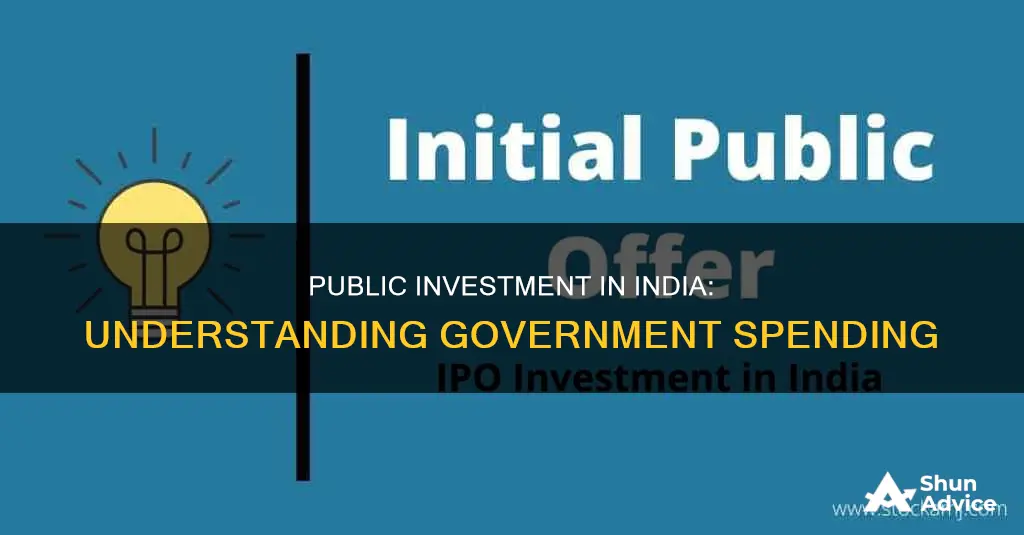
Public investment is an important driver of economic growth in India. It involves investments made by the central or state government for public welfare, with funds collected from taxes. In the 2022-23 financial year, the Government of India decided to increase public investment by 35%. This type of investment is crucial as it boosts the economy, improves infrastructure, and generates new jobs.
In India, public investment is directed towards sectors such as agriculture, infrastructure, healthcare, defence, and education. While the private sector also plays a role in these areas, public investment is particularly important in sectors that struggle to attract private investment, such as agriculture.
The Indian government has been increasing its spending in the healthcare sector, allocating around 2.1% of the nation's GDP in 2021-22. Similarly, public investment in infrastructure development has increased by 10%, although more investment is needed.
Public investment in India is essential for improving the lives of citizens, especially those in rural areas, and for attracting foreign direct investment (FDI).
| Characteristics | Values |
|---|---|
| Public investment in infrastructure | Rising |
| Public investment in real estate | Rising |
| Public investment in manufacturing | Rising |
| Public investment in healthcare | Rising |
| Public investment in education | Rising |
| Public investment in agriculture | Rising |
What You'll Learn

Public investment in India's agricultural sector
Public investment in agriculture can take various forms, such as infrastructure development, technological advancements, and social capital enhancement. Examples include the computerization of Primary Agricultural Credit Societies (PACS), which improves credit access and management for farmers, and the establishment of cold storage facilities, which helps reduce post-harvest losses and ensures better price realization.
The Indian government has implemented several initiatives to promote public investment in agriculture. These include:
- Production-Linked Incentive (PLI) schemes in multiple sectors, including agriculture, to boost domestic manufacturing and attract foreign investment.
- National Logistics Policy (NLP), which aims to reduce logistics costs and improve India's competitiveness in the global market.
- Investor-friendly policies, such as easing FDI norms and the introduction of the Foreign Investment Facilitation Portal (FIFP) for easier facilitation of FDI proposals.
- National Monetization Pipeline (NMP), providing a comprehensive view of investment opportunities in infrastructure.
- Phased Manufacturing Programme (PMP) to promote domestic manufacturing, particularly in the electric vehicle industry.
The impact of public investment in agriculture can have far-reaching effects. For instance, investment in irrigation structures has positive social, ecological, and environmental externalities. Additionally, it has the potential to significantly influence health, nutrition, and poverty reduction. However, without a substantial increase in public expenditure, there is a risk of counterproductive outcomes, such as increased agricultural exports without a corresponding rise in agricultural output, leading to sharp inflation and adverse effects on non-agricultural sectors.
Understanding Investment: 338 Investment Managers and Their Role
You may want to see also

Public investment in infrastructure development
One of the key initiatives in this regard is the National Infrastructure Pipeline (NIP), which envisages an investment of INR 111 Lakh Cr over 2020-2025, with an annual average investment of almost INR 22 Lakh Cr. Under the NIP, there are currently projects worth Rs. 108 trillion (US$1.3 trillion) at different stages of implementation. The government has also introduced the PM Gatishakti National Master Plan (NMP), which aims to enhance multimodal connectivity infrastructure in various economic zones by bringing together various infrastructure schemes under a digital platform.
Public-Private Partnerships (PPPs) have played a vital role in infrastructure development in India, particularly in the construction of airports, ports, highways, and logistics parks. The private sector's participation is crucial for financing key infrastructure projects, and the government has offered various incentives to encourage their involvement. For example, the government has extended the tenure of 50-year interest-free loans to state governments, helping them undertake infrastructure investments.
The infrastructure sector in India includes power, bridges, dams, roads, and urban infrastructure development. Historically, more than 80% of the country's infrastructure spending has gone toward funding transportation, electricity, and water and irrigation. However, the government has also started to focus on other sectors, such as housing, digital infrastructure, and environmental sustainability.
The government has allocated significant funds for the development of the transport sector, including roads and highways, railways, and urban public transport. The construction of national highways is a key initiative, with a target of developing a 2 lakh-km network by 2025. The government has also set ambitious targets for the expansion of airports and the development of waterways and multi-modal logistics parks.
The railway sector is also undergoing significant development, with projects such as the Mumbai-Ahmedabad Speed Rail Corridor and the introduction of semi high-speed Vande Bharat trains. The sector aims to become a net-zero carbon emitter by 2030 and has already commissioned significant renewable energy capacity.
The port sector has also seen improvements, with the "Turn Around Time" for Indian ports outperforming those of the USA, Australia, and Singapore, according to the World Bank's Logistics Performance Index (LPI) Report 2023. The Sagarmala scheme, a flagship Central Sector Scheme, promotes port-led development by harnessing India's extensive coastline and navigable waterways.
The development of infrastructure in India has a multiplier effect on demand and efficiency, increasing commercial and entrepreneurship opportunities. It also plays a pivotal role in driving economic growth and overall development, making it a key enabler for India to become a global economic powerhouse.
Investment Management Services: What Do They Offer?
You may want to see also

Public investment in the healthcare sector
The Indian healthcare sector is witnessing unprecedented growth, with private equity and venture capital investments surpassing $1 billion in the first five months of 2024, marking a 220% increase from the previous year. The country's competitive advantage lies in its large pool of well-trained medical professionals, as well as its cost-competitiveness compared to other Asian and Western countries. The low cost of medical services has resulted in a rise in medical tourism, attracting patients from across the world.
The Indian government has also been increasing its public expenditure on healthcare, with the Health Ministry aiming to reach 2.5% of GDP by FY25. In the Union Budget 2024-25, the government allocated Rs. 89,287 crores ($10.70 billion) to the healthcare sector, with a focus on enhancing accessibility and innovation. The government is also planning to introduce a credit incentive programme worth Rs. 50,000 crore ($6.8 billion) to boost the country's healthcare infrastructure.
The hospital sector in India is expected to reach INR 18,348.78 billion by FY 2027, growing at a CAGR of 18.24%. The telemedicine market, which is the maximum potential eHealth segment in India, is expected to touch $5.4 billion by 2025, growing at a CAGR of 31%. The Indian Medtech Industry, estimated to be $10.63 billion in 2020, is projected to reach $50 billion by 2025.
The Indian healthcare sector has seen a number of investments and developments in recent years, including:
- The government's Ayushman Bharat Health Infrastructure Mission, which aims to fortify the country's healthcare infrastructure.
- The launch of the Ayushman Bharat Digital Mission in September 2021, which will provide every citizen with a digital health ID.
- The National Digital Health Blueprint, which is expected to unlock an incremental economic value of over $200 billion for the healthcare industry over the next 10 years.
- The government's plan to spend over $200 billion on medical infrastructure by 2024.
- The National Tele Mental Health Programme, which has received over 1.44 million calls on the Tele-MANAS Helpline.
- The Pradhan Mantri Bhartiya Janaushadhi Pariyojana, which recorded $119 million in sales in October 2024, providing affordable medicines through Jan Aushadhi Kendras.
Asset Investment Guide for Indians: A Beginner's Overview
You may want to see also

Public investment in the defence sector
India has the world's second-largest armed force, with 1.44 million active personnel and the largest volunteer military of 5.1 million personnel. The defence sector is thus strategically important to the country. The total budget sanctioned for the Indian military for the 2021 financial year was US$67 billion, the third-largest annual defence budget in the world.
The defence sector in India is divided into the public and private sectors, with 60% of the domestic defence industry being government-owned. The public sector includes entities such as NTRO, CSIR, PRL, DRDO and its 50 labs, 4 defence shipyards, and 12 defence public sector undertakings (PSUs).
The Indian government has identified the defence sector as a key focus area for the 'Aatmanirbhar Bharat' or Self-Reliant India initiative, aiming to establish indigenous manufacturing infrastructure supported by a robust research and development ecosystem. The government has set a target of achieving a turnover of US$26 billion in the aerospace and defence manufacturing industry by 2025, including US$5 billion in exports.
To support the domestic defence industry, the government has implemented policies to ensure transparency, predictability, and ease of doing business. This includes de-licensing, de-regulation, export promotion, and foreign investment liberalization. The Foreign Direct Investment (FDI) in the defence sector has been enhanced to 74% through the automatic route and 100% through the government route. The government has also established two dedicated Defence Industrial Corridors in the states of Tamil Nadu and Uttar Pradesh to act as clusters of defence manufacturing, leveraging existing infrastructure and human capital.
The defence sector in India offers significant investment opportunities, particularly in the following areas:
- Defence Manufacturing: India aims to become one of the top five global producers of aerospace and defence manufacturing. The Defence Production Policy of 2018 set an annual export target of US$5 billion by 2025. The private sector and defence public sector entities contribute significantly to exports, with about 100 companies involved in the export of military gear.
- Defence Procurement and Acquisition: India has implemented a new defence procurement, acquisition, and manufacturing policy to reduce imports and enhance domestic manufacturing. The Defence Acquisition Procedure (DAP) 2020 aims to empower the Indian domestic industry through the 'Make in India' initiative, encouraging FDI to establish manufacturing hubs for import substitution and exports.
- Research and Development: The Indian defence industry's research and development (R&D) spending is relatively low compared to global peers, with a focus on indigenisation of defence technologies. The DRDO and ISRO have agreed to collaborate on India's crewed orbital spacecraft project, with DRDO tailoring its defence capabilities to suit the needs of the human space mission.
- Defence Corridors: The two Defence Industrial Corridors in Uttar Pradesh and Tamil Nadu have signed Memorandums of Understanding (MoUs) with industries, representing investments worth US$24.45 billion. These corridors provide opportunities for investors to establish manufacturing facilities and supply chains within these clusters.
- Export Promotion: India's defence exports have reached an all-time high, with a 32.5% increase in the fiscal year 2023-24 compared to the previous year. The government has been pushing for greater indigenisation of military hardware, and the defence sector offers export opportunities for a range of defence products, including weapons systems, electronics, software, and vehicles.
In conclusion, public investment in the defence sector in India is significant, with the government committed to developing a robust defence manufacturing ecosystem. The defence sector offers a range of investment opportunities, particularly in defence manufacturing, procurement, R&D, and export promotion. The government's focus on self-reliance and the establishment of defence corridors provide a favourable environment for investors looking to capitalise on the growth prospects in this sector.
Pzena Investment Management: Unraveling the Symbol's Significance
You may want to see also

Public investment in education
In 2019-20, India spent Rs 6.43 lakh crore ($88 billion) of public funds on education. However, as a percentage of its gross domestic product (GDP), India spent only 3.1% on education in 2019-20, falling short of the recommended 6% by every national education policy (NEP) since 1968. This under-spending has impacted over one million government schools, resulting in poor learning outcomes.
To address this issue, the central and state governments contribute to education spending in various ways. The central government provides partial or full funding for centrally sponsored schemes and central sector schemes. While centrally sponsored schemes, such as the Samagra Shiksha Abhiyan, are mostly funded by the Centre and the state in a 60:40 ratio, central sector schemes like scholarships for Scheduled Castes and Tribes and schools for talented children in rural areas are fully funded by the Centre. However, these central sector schemes form only a small proportion of education funding in India, typically 1-2%.
State governments play a more significant role in education funding, with states like Bihar receiving up to 40-50% of their education funding from the central government, while others like Maharashtra rely on the Centre for only 7-10%. States also have their own schemes, such as incentives for girls in secondary school, and contribute the majority of education funds.
Despite these efforts, challenges remain, including insufficient teacher training, a lack of digital infrastructure, and delayed payments to states, impacting the utilisation of funds. To improve learning outcomes and meet the goals of the 2020 New Education Policy, experts emphasise the need for increased and more efficient spending in the education sector.
The importance of public investment in education is evident, and it is crucial for India to continue prioritising and improving education funding to ensure equitable development and enhance the earning potential of its citizens.
A Guide to Investing in India's Wedding Hall Industry
You may want to see also
Frequently asked questions
Public investment is an investment made by the central or state government for public welfare. It is carried out in specific sectors, such as agriculture, infrastructure, health, and education, using revenue collected from taxes.
The major sectors for public investment in India include agriculture, infrastructure, healthcare, defence, and education.
Public investment has the potential to improve infrastructure, attract foreign direct investment (FDI), decrease unemployment, generate new jobs, increase production capacity, and promote rural development. It also provides competition to private investors, preventing monopolies and offering competitive prices for essential goods and services.
The relationship between public and private investment in India has evolved over time. Between 1950 and 2012, public investment tended to crowd out private investment. However, structural reforms in the 1980s and 1990s, including pro-business policies and product-market liberalization, reversed this trend. More recently, public investment has become complementary to private investment, with the two types of investment co-existing and contributing to India's economic growth.







